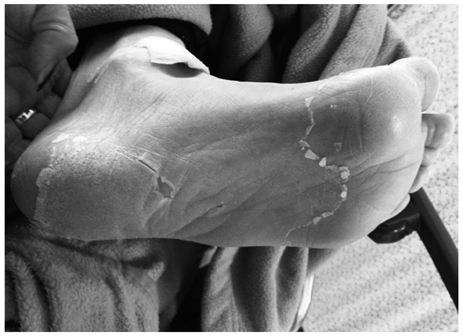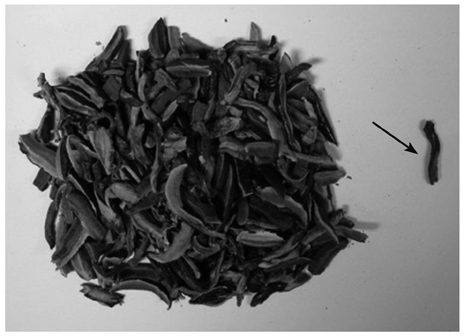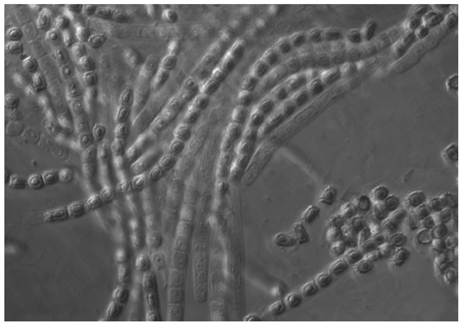Yonsei Med J.
2013 Jan;54(1):265-268. 10.3349/ymj.2013.54.1.265.
Two Cases of Mushroom Poisoning by Podostroma Cornu-Damae
- Affiliations
-
- 1Department of Internal Medicine, Yonsei University College of Medicine, Seoul, Korea. shhan74@yuhs.ac
- 2Agricultural Microbiology Team, National Academy of Agricultural Science, Rural Development Administration, Suwon, Korea.
- KMID: 1776950
- DOI: http://doi.org/10.3349/ymj.2013.54.1.265
Abstract
- Podostroma cornu-damae is a rare fungus that houses a fatal toxin in its fruit body. In this case report, two patients collected and boiled the wild fungus in water, which they drank for one month. One patient died, presenting with desquamation of the palms and soles, pancytopenia, severe sepsis and multiple organ failure. The other patient recovered after one month of conservative care after admission. We found a piece of Podostroma cornu-damae in the remaining clusters of mushrooms. Mushroom poisoning by Podostroma cornu-damae has never been previously reported in Korea.
Keyword
MeSH Terms
Figure
Reference
-
1. Ford M, Delaney KA, Ling L, Erickson T. Clinical Toxicology. 2001.2. Klein AS, Hart J, Brems JJ, Goldstein L, Lewin K, Busuttil RW. Amanita poisoning: treatment and the role of liver transplantation. Am J Med. 1989. 86:187–193.
Article3. Lee HY, Park CW, Cho JH, Cheon SB, Moon JB. A case of Naematololma Fasciculare poisoning due to misidentification as an edible mushroom. J Korean Soc Emerg Med. 2011. 22:181–183.4. Shi GQ, Huang WL, Zhang J, Zhao H, Shen T, Fontaine RE, et al. Clusters of sudden unexplained death associated with the mushroom, Trogia venenata, in rural Yunnan Province, China. PLoS One. 2012. 7:e35894.
Article5. Yokoyama K, Gonmori K. [Increase of poisoning by tropical mushrooms in Japan in recent years]. Chudoku Kenkyu. 2009. 22:240–248.6. Saikawa Y, Okamoto H, Inui T, Makabe M, Okuno T, Suda T, et al. Toxic principles of a poisonous mushroom Podostroma cornu-damae. Tetrahedron. 2001. 57:8277–8281.
Article7. NT P. Enumeration of mushrooms harvested by RR. PP. Soulie at Farges, in eastern Tibet and Su-tchuen. Newsl Mycol Soc Fr. 1895. 11:196–199.8. Izawa H. Podostroma cornu-damae(pat). 1994. Mycobank International Mycological Association.9. Beware the toxic mushroom, Podostroma cornu-damae which resembles Ganoderma lucidum. Rural Development Administration News. 2012.10. Koichi M, Haruo T, Toshihiro Y, Masami O, Sadao N, Koichiro K. Case report: food poisoning to death by Podostroma cornu-damae, its case history and autopsy findings. Acta Criminol Med Leg Jan. 2003. 69:14–20.11. Suzuki M, Katoh Y, Kumagai H, Saitoh M, Ishikawa H, Itoh H, et al. [Successful treatment in a case of podostroma cornu-damae poisoning, a deadly poisonous mushroom]. Chudoku Kenkyu. 2002. 15:177–182.
- Full Text Links
- Actions
-
Cited
- CITED
-
- Close
- Share
- Similar articles
-
- Two cases of incidental Podostroma cornu-damae poisoning
- Mushroom Poisoning by Podostroma cornu-damae: A Case Report and Review of the Literature
- A Case of Podostroma Cornu-Damae Intoxication Similar to Drug Hypersensitivity Syndrome
- An Elderly Man with Fatal Respiratory Failure after Eating a Poisonous Mushroom Podostroma cornu-damae
- A Case of Podostroma Cornu-Damae Intoxication Induced Pancytopenia and Skin Desquamation: Successful Treatment with Granulocyte Colony Stimulation Factor (G-CFS)




